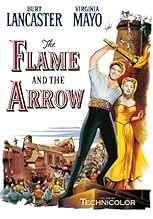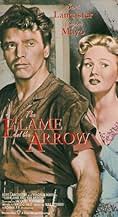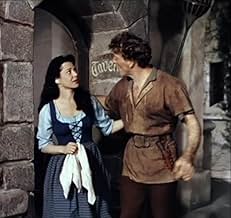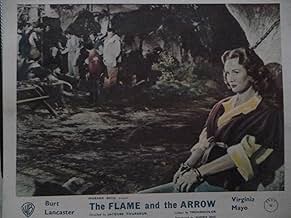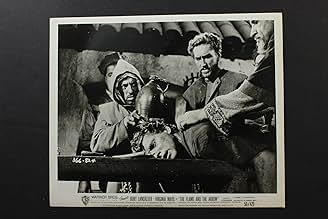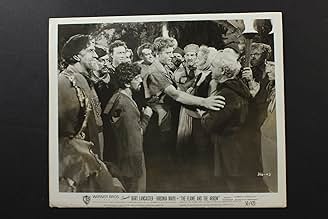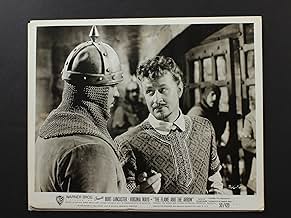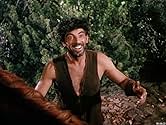PUNTUACIÓN EN IMDb
6,8/10
4,5 mil
TU PUNTUACIÓN
Dardo, un personaje parecido a Robin Hood, y sus fieles seguidores utilizan una ruina romana en la Lombardía medieval como cuartel general mientras llevan a cabo una insurgencia contra sus c... Leer todoDardo, un personaje parecido a Robin Hood, y sus fieles seguidores utilizan una ruina romana en la Lombardía medieval como cuartel general mientras llevan a cabo una insurgencia contra sus conquistadores hessianos.Dardo, un personaje parecido a Robin Hood, y sus fieles seguidores utilizan una ruina romana en la Lombardía medieval como cuartel general mientras llevan a cabo una insurgencia contra sus conquistadores hessianos.
- Nominado para 2 premios Óscar
- 2 premios y 2 nominaciones en total
Lynn Baggett
- Francesca
- (as Lynne Baggett)
Paul Baxley
- Guard
- (sin acreditar)
Leon Belasco
- Arturo of Milan
- (sin acreditar)
- …
Ray Beltram
- Townsman
- (sin acreditar)
Richard Brehm
- Outlaw
- (sin acreditar)
George Bruggeman
- Guard
- (sin acreditar)
Reseñas destacadas
Lively, colorful period romp in the Warners’ style made in the wake of ADVENTURES OF DON JUAN (1948) – featuring the same villain, Robert Douglas, no less – but actually fashioned after their most successful swashbuckler, THE ADVENTURES OF ROBIN HOOD (1938).
Burt Lancaster – with his acrobatic training and cheerful countenance in full bloom – is perfect casting for the heroic role of Dardo, a kind of Italian Robin Hood (even down to displaying similar prowess as an archer); Virginia Mayo, then, makes for an ideal heroine – like Olivia De Havilland’s Maid Marian, playing a noble woman who’s gradually drawn to the outlaw’s cause. Again, like the 1938 Robin Hood film, we have two villains: Frank Allenby as a tyrant known as “The Hawk” and the afore-mentioned Douglas as a Marquis; the latter’s role is interesting in that, banished by the former for tax evasion, he manages to infiltrate Lancaster’s band (along with his smart companion, a troubadour played by Norman Lloyd) and outwardly reform – but, when the opportunity arises, proceeds to reveal their plan of attack to Allenby!
Other twists and quirks to the Robin Hood formula (the sharp script was written by Waldo Salt, later an Oscar winner for MIDNIGHT COWBOY [1969]!) are the fact that Lancaster’s wife has left him for Allenby - their spirited son has remained with Lancaster, whom he idolizes, but is eventually captured and thought good manners against his will; when Lancaster imprisons Mayo in exchange for his son’s freedom, he keeps her chained by the neck to a tree!; for no apparent reason other than that he's able to, one of Lancaster’s men uses his feet to write ransom notes, etc.; Lancaster is sent to the gallows but, here, he gives himself up rather than being captured and actually fakes his own death!; and the climactic struggle inside the castle, which the gang penetrate incognito (this time dressed-up as a band of strolling players). The obligatory swordfight between Lancaster and Douglas, then, is given a novel touch by being partly set in the dark – the only evident nod to the noir style director Tourneur is best-known for!
The film itself received a couple of Oscar nominations for Ernest Haller’s gorgeous cinematography and Max Steiner’s marvelous score (it too bears a striking resemblance to Erich Wolfgang Korngold’s unforgettable work on THE ADVENTURES OF ROBIN HOOD – as do the castle interiors – but this takes nothing away from the quality of THE FLAME AND THE ARROW itself!). Also worth noting in the cast is Nick Cravat as Lancaster’s mute sidekick: in the star’s days as an acrobat, he had been his partner and would often work with him in films – basically reprising his role here in Lancaster’s next swashbuckler, the seafaring THE CRIMSON PIRATE (1952; incidentally, also surprisingly but vigorously helmed by an expert in film noir, Robert Siodmak). Speaking of the latter, a couple of years back I re-acquainted myself with it via a rental of Warner’s bare-bones DVD edition – but its predecessor/companion piece is, mysteriously, still M.I.A. on disc...
Burt Lancaster – with his acrobatic training and cheerful countenance in full bloom – is perfect casting for the heroic role of Dardo, a kind of Italian Robin Hood (even down to displaying similar prowess as an archer); Virginia Mayo, then, makes for an ideal heroine – like Olivia De Havilland’s Maid Marian, playing a noble woman who’s gradually drawn to the outlaw’s cause. Again, like the 1938 Robin Hood film, we have two villains: Frank Allenby as a tyrant known as “The Hawk” and the afore-mentioned Douglas as a Marquis; the latter’s role is interesting in that, banished by the former for tax evasion, he manages to infiltrate Lancaster’s band (along with his smart companion, a troubadour played by Norman Lloyd) and outwardly reform – but, when the opportunity arises, proceeds to reveal their plan of attack to Allenby!
Other twists and quirks to the Robin Hood formula (the sharp script was written by Waldo Salt, later an Oscar winner for MIDNIGHT COWBOY [1969]!) are the fact that Lancaster’s wife has left him for Allenby - their spirited son has remained with Lancaster, whom he idolizes, but is eventually captured and thought good manners against his will; when Lancaster imprisons Mayo in exchange for his son’s freedom, he keeps her chained by the neck to a tree!; for no apparent reason other than that he's able to, one of Lancaster’s men uses his feet to write ransom notes, etc.; Lancaster is sent to the gallows but, here, he gives himself up rather than being captured and actually fakes his own death!; and the climactic struggle inside the castle, which the gang penetrate incognito (this time dressed-up as a band of strolling players). The obligatory swordfight between Lancaster and Douglas, then, is given a novel touch by being partly set in the dark – the only evident nod to the noir style director Tourneur is best-known for!
The film itself received a couple of Oscar nominations for Ernest Haller’s gorgeous cinematography and Max Steiner’s marvelous score (it too bears a striking resemblance to Erich Wolfgang Korngold’s unforgettable work on THE ADVENTURES OF ROBIN HOOD – as do the castle interiors – but this takes nothing away from the quality of THE FLAME AND THE ARROW itself!). Also worth noting in the cast is Nick Cravat as Lancaster’s mute sidekick: in the star’s days as an acrobat, he had been his partner and would often work with him in films – basically reprising his role here in Lancaster’s next swashbuckler, the seafaring THE CRIMSON PIRATE (1952; incidentally, also surprisingly but vigorously helmed by an expert in film noir, Robert Siodmak). Speaking of the latter, a couple of years back I re-acquainted myself with it via a rental of Warner’s bare-bones DVD edition – but its predecessor/companion piece is, mysteriously, still M.I.A. on disc...
Set in a little-remembered historical setting, the 1950 Warner Bros. swashbuckler "The Flame and the Arrow" finds its star, Burt Lancaster, showing off his great acrobatic prowess for the first time on screen. Since his spectacular debut in 1946's "The Killers," Lancaster had been featured in a run of moody, dramatic and noirish thrillers, but here, in his 10th picture (not counting his cameo appearance in 1947's "Variety Girl"), Burt finally seemed to be having some fun on the big screen. Appearing in color for the first time, big Burt here plays a character named Dardo Bartoli. A single father who lives in the Lombardy region in what we must presume to be the mid-12th century (the period when the Lombard League was formed to oust the Emperor Frederick Barbarossa and his Hessians, who had captured Milan in 1158 and burned it in 1162), Dardo has more than ample reason to be aggrieved with the Hessian Count Ulrich, aka The Hawk (hissably portrayed by Frank Allenby). Dardo's ex-wife had earlier "taken up" with the count, and his young son Rudi is soon kidnapped and ensconced in the count's well-guarded castle. Thus, accompanied by his friend Piccolo (Lancaster's boyhood pal Nick Cravat), the two attempt a rescue, but must ultimately content themselves with the kidnapping of the count's luscious niece, Anne of Hesse (beautiful-as-always Virginia Mayo), in the hopes of an exchange. But complications, both logistical and romantic, naturally ensue....
"The Flame and the Arrow" is a film that seems to be not as highly regarded as Lancaster and Cravat's follow-up swashbuckler, 1952's "The Crimson Pirate," which, in the interest of complete honesty--and to my own personal embarrassment--I must admit to not having seen. Still, the duo's initial outing has much to offer to the fun-loving fan of Saturday matinée-type entertainments. Lancaster and Cravat--who had formed the Lang and Cravat acrobatic team in the 1930s and performed extensively in circuses and nightclubs--get to show off their physical stunts here in various action situations, and although the two were hardly youngsters at this point (Burt was 37; Nick, 39), they are still remarkably impressive. No need for stuntmen with these two around, that's for sure! The film throws in a number of rousing combat scenes, and concludes with one of the great unsung swordfights in screen history, between Dardo and the traitorous Marchese Granazia (a nicely ambiguous performance from Robert Douglas); just look at how ferociously Burt swings his sword around in this scene! Virginia Mayo, a year after her terrific performance as James Cagney's moll Verna in "White Heat," looks absolutely sensational here in supersaturated Technicolor, and famed character actors Aline MacMahon and Victor Kilian are just fine in smaller roles. But this is most assuredly Burt's picture all the way, and his manifest joy in playing a physical-action character in a period swashbuckler is quite contagious. With that flashing grin and million-dollar set of teeth, no wonder all the girls in Lombardy seem to have a major thang for him! And thus, how little sympathy the viewer has for Dardo's wife, Francesca (Lynn Baggett), who would give up this man, as well as her cute son (appealingly played by young Gordon Gebert), in order to live with the evil but wealthy count!
"The Flame and the Arrow" was directed by the great Jacques Tourneur, the French-born filmmaker who is perhaps best remembered today for his 1940s RKO horror films--"The Cat People," "I Walked With a Zombie" and "The Leopard Man" (all made for producer Val Lewton)--as well as for the cult item "Curse of the Demon"; here, Tourneur demonstrates that he could be just as skilled and effective in another, nonhorror genre. Finally, I would be remiss if I failed to mention the lovely score that has been provided here by the renowned Max Steiner, who had previously contributed to such "minor" films as "King Kong," "Top Hat," "Gone With the Wind," "Sergeant York," "Now, Voyager," "Casablanca," "Mildred Pierce," "The Treasure of the Sierra Madre" and, again, "White Heat," in addition to a few hundred others (what an amazing career!). A classy affair from start to finish, "The Flame and the Arrow" is very much your standard Hollywood adventure fare, but done to a turn by a cast and crew that obviously took great pride in their craft; truly, a rousing entertainment for audience members of all ages.
"The Flame and the Arrow" is a film that seems to be not as highly regarded as Lancaster and Cravat's follow-up swashbuckler, 1952's "The Crimson Pirate," which, in the interest of complete honesty--and to my own personal embarrassment--I must admit to not having seen. Still, the duo's initial outing has much to offer to the fun-loving fan of Saturday matinée-type entertainments. Lancaster and Cravat--who had formed the Lang and Cravat acrobatic team in the 1930s and performed extensively in circuses and nightclubs--get to show off their physical stunts here in various action situations, and although the two were hardly youngsters at this point (Burt was 37; Nick, 39), they are still remarkably impressive. No need for stuntmen with these two around, that's for sure! The film throws in a number of rousing combat scenes, and concludes with one of the great unsung swordfights in screen history, between Dardo and the traitorous Marchese Granazia (a nicely ambiguous performance from Robert Douglas); just look at how ferociously Burt swings his sword around in this scene! Virginia Mayo, a year after her terrific performance as James Cagney's moll Verna in "White Heat," looks absolutely sensational here in supersaturated Technicolor, and famed character actors Aline MacMahon and Victor Kilian are just fine in smaller roles. But this is most assuredly Burt's picture all the way, and his manifest joy in playing a physical-action character in a period swashbuckler is quite contagious. With that flashing grin and million-dollar set of teeth, no wonder all the girls in Lombardy seem to have a major thang for him! And thus, how little sympathy the viewer has for Dardo's wife, Francesca (Lynn Baggett), who would give up this man, as well as her cute son (appealingly played by young Gordon Gebert), in order to live with the evil but wealthy count!
"The Flame and the Arrow" was directed by the great Jacques Tourneur, the French-born filmmaker who is perhaps best remembered today for his 1940s RKO horror films--"The Cat People," "I Walked With a Zombie" and "The Leopard Man" (all made for producer Val Lewton)--as well as for the cult item "Curse of the Demon"; here, Tourneur demonstrates that he could be just as skilled and effective in another, nonhorror genre. Finally, I would be remiss if I failed to mention the lovely score that has been provided here by the renowned Max Steiner, who had previously contributed to such "minor" films as "King Kong," "Top Hat," "Gone With the Wind," "Sergeant York," "Now, Voyager," "Casablanca," "Mildred Pierce," "The Treasure of the Sierra Madre" and, again, "White Heat," in addition to a few hundred others (what an amazing career!). A classy affair from start to finish, "The Flame and the Arrow" is very much your standard Hollywood adventure fare, but done to a turn by a cast and crew that obviously took great pride in their craft; truly, a rousing entertainment for audience members of all ages.
THE FLAME AND THE ARROW is one (1) of those films that every ten (10) years we see and are pleasantly surprised how well it holds up. It is also amazing how it appears and disappears. In the 60's it was on quite frequently, the 70's not so. American Movie Classics (AMC) showed it often in the 80's and it came out on VHS. Now it is been buried again so a new generation of viewers are going to have to wait till it comes out on DVD. I have just watched my 80's VHS recently so this is based upon it.
It is what other commentators called it ROBIN HOOD JR. That does not mean it is small or poorly made film. Instead you see the full power of a major studio Warner Brothers (WB) behind it. The props and sets many coming from larger films (Adventures of Robin Hood, Elizabeth and Essex, The Adventures of Don Juan) are quite evident and effectively integrated into the story line. Burt Lancaster's supporting cast consists of the current studio stock company, all professionals. Who knew what to deliver and did so. It had the full Three (3) Strip Technicolor process in all it's glory and finally Max Steiner's score. Romantic and rich and appropriate for such a concept. This is a super 'B' film and there is no disgrace in that. We have seen plenty of 'A' films today that are not half as well done.
It is though Burt Lancaster that is the central focus of the film. His first 'independent' production he knew if he did not carry it well it would have failed. Every time he is on the screen he is the focus of attention and fortunately he is on very often. Whether exchanging insults, engaging in acrobatics or romance he is hitting the target every time. He is ably supported by Virginia Mayo as his leading lady. A underrated actress with a attractive and strong physical presence. Lets be frank, does anyone believe that DARDO would fall for some skinny twit like Audrey Hepburn (or today Angelina Jolie) no way. We did not believe that when Sean Connery did in ROBIN AND MARIAN!
So if you can check this selection out. Your library may have a copy (mine does) on VHS. We are sure it will be out sometime on DVD. Lancaster later made another period film THE CRIMSON PIRATE. Not quite as good but still fun, but it seemed to lack the backing. polish and push that WB gave THE FLAME AND THE ARROW.
ADDENDUM; NOW AVAILABLE ON DVD.
It is what other commentators called it ROBIN HOOD JR. That does not mean it is small or poorly made film. Instead you see the full power of a major studio Warner Brothers (WB) behind it. The props and sets many coming from larger films (Adventures of Robin Hood, Elizabeth and Essex, The Adventures of Don Juan) are quite evident and effectively integrated into the story line. Burt Lancaster's supporting cast consists of the current studio stock company, all professionals. Who knew what to deliver and did so. It had the full Three (3) Strip Technicolor process in all it's glory and finally Max Steiner's score. Romantic and rich and appropriate for such a concept. This is a super 'B' film and there is no disgrace in that. We have seen plenty of 'A' films today that are not half as well done.
It is though Burt Lancaster that is the central focus of the film. His first 'independent' production he knew if he did not carry it well it would have failed. Every time he is on the screen he is the focus of attention and fortunately he is on very often. Whether exchanging insults, engaging in acrobatics or romance he is hitting the target every time. He is ably supported by Virginia Mayo as his leading lady. A underrated actress with a attractive and strong physical presence. Lets be frank, does anyone believe that DARDO would fall for some skinny twit like Audrey Hepburn (or today Angelina Jolie) no way. We did not believe that when Sean Connery did in ROBIN AND MARIAN!
So if you can check this selection out. Your library may have a copy (mine does) on VHS. We are sure it will be out sometime on DVD. Lancaster later made another period film THE CRIMSON PIRATE. Not quite as good but still fun, but it seemed to lack the backing. polish and push that WB gave THE FLAME AND THE ARROW.
ADDENDUM; NOW AVAILABLE ON DVD.
While this isn't the best adventure film I have ever seen, it might just be the highest energy film and featured stunts you just won't see in films by Errol Flynn or Ronald Coleman. That's because the star, Burt Lancaster, does most of his own stunts--having been a circus performer in a previous career along with his partner, Nick Cravat! It's obvious that he is one of the most athletic leading men in history and apart from his film, TRAPEZE, it's the most incredible stunt-work you'll see him do on film. A couple years after making this film, Lancaster returned for THE CRIMSON PIRATE--a better film, but one that features less of the athleticism of THE FLAME AND THE ARROW. It is interesting that Lancaster's circus partner, Nick Cravat, also plays his best friend in this film and several others (such as THE CRIMSON PIRATE). Some of their stunt-work together is truly amazing.
As far as the plot goes, it's a reworking of the Robin Hood story, but this time it's set in Lombardy (a region in North-central Italy that includes Milan) and the invaders are Hessians (from the region around Frankfurt, Germany). Apart from that, the story elements are very, very similar. Even the part played by Virginia mayo is a copy of Maid Marian from Robin Hood. However, despite being a bit recycled, the film is exciting and fun--if also a bit like "fluff". Good old fashioned, but not especially deep fun, it's a must for Burt Lancaster films--he's dynamite.
As far as the plot goes, it's a reworking of the Robin Hood story, but this time it's set in Lombardy (a region in North-central Italy that includes Milan) and the invaders are Hessians (from the region around Frankfurt, Germany). Apart from that, the story elements are very, very similar. Even the part played by Virginia mayo is a copy of Maid Marian from Robin Hood. However, despite being a bit recycled, the film is exciting and fun--if also a bit like "fluff". Good old fashioned, but not especially deep fun, it's a must for Burt Lancaster films--he's dynamite.
I honestly feel if anyone is does this film down for it's jovial nature then they surely are missing the point. I wasn't around at the time of its release, but I would have been surprised if the makers had marketed it as a searing swashbuckler for the ages. The film is fun, it tells a fun tale, and yes it's in the Robin Hood arc of plot structure, but ultimately it's a tale well worth watching due to the extended dexterity of its stars.
I would think that tagging this film "The Acrobatic Peasant Vs The Horrible Hessian Lord" would serve it about right, the cast are having fun and really the viewer should be in on the joviality unfolding as well. Burt Lancaster and his old circus performing pal Nick Cravat dazzle with flings and flops, arrows and lances, and it all works for what I term perfect Sunday afternoon entertainment.
All that and Viginia Mayo has a smile that could stop an army in its tracks, what more do you want ?, hooray ! 7/10
I would think that tagging this film "The Acrobatic Peasant Vs The Horrible Hessian Lord" would serve it about right, the cast are having fun and really the viewer should be in on the joviality unfolding as well. Burt Lancaster and his old circus performing pal Nick Cravat dazzle with flings and flops, arrows and lances, and it all works for what I term perfect Sunday afternoon entertainment.
All that and Viginia Mayo has a smile that could stop an army in its tracks, what more do you want ?, hooray ! 7/10
¿Sabías que...?
- CuriosidadesNick Cravat, who plays Piccolo, was an acrobat who was teamed with Burt Lancaster before Lancaster became a star. He appears in many of Lancaster's movies. In this one, and in El temible burlón (1952), he plays a mute. The reason was that his thick Brooklyn accent, which he could not lose, would have been wildly out of place in such period pieces.
- PifiasWhen Piccolo is fighting the guardsman in the balcony he flips his sword around and holds the blade with his hand (showing it cannot be sharp) and then whacks the guardsman with the broad side of the blade near the hilt, bending it at least 20-25 degrees.
- ConexionesReferenced in The John Player Lecture with Burt Lancaster (1972)
Selecciones populares
Inicia sesión para calificar y añadir a tu lista para recibir recomendaciones personalizadas
- How long is The Flame and the Arrow?Con tecnología de Alexa
Detalles
- Fecha de lanzamiento
- País de origen
- Idioma
- Títulos en diferentes países
- El falcó i la fletxa
- Localizaciones del rodaje
- Empresas productoras
- Ver más compañías en los créditos en IMDbPro
Taquilla
- Presupuesto
- 1.600.000 US$ (estimación)
- Recaudación en todo el mundo
- 6713 US$
- Duración
- 1h 28min(88 min)
- Relación de aspecto
- 1.37 : 1
Contribuir a esta página
Sugerir un cambio o añadir el contenido que falta


